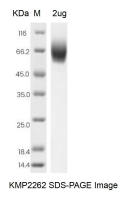Human CD33L3 Protein, Fc Tag
-
产品编号
KMP2262
-
别名
唾液酸结合免疫球蛋白样凝集素-15, Sialic acid-binding Ig-like lectin 15, Siglec-15
-
规格
- 50ug
- 100ug
- 200ug
| Alias | 唾液酸结合免疫球蛋白样凝集素-15, Sialic acid-binding Ig-like lectin 15, Siglec-15 |
| Catalog Number | KMP2262 |
| Product Description | The Human CD33L3 Protein(KMP2262) is produced in HEK293 Cells and the target gene encoding Phe20-Thr263 is expressed with a Fc tag at the C-terminus. |
| Molecular Name | CD33L3 |
| Species | Human |
| Host | HEK293 Cells |
| Size | 50ug, 100ug, 200ug |
| Purity | >95% as determined by SDS-PAGE |
| Purification | Affinity purification |
| Endotoxin | <1.0 EU/ug determined by the LAL method |
| Formulation | PBS, 150mM Nacl, 0.3% Chaps, 5% Trehalose, pH7.4 |
| Background | Human Siglec-15 is a transmembrane glycoprotein in the Siglec family. Siglecs are type I transmembrane proteins where the NH3+-terminus is in the extracellular space and the COO--terminus is cytosolic. Each Siglec contains an N-terminal V-type immunoglobulin domain(Ig domain) which acts as the binding receptor for sialic acid. These lectins are placed into the group of I-type lectins because the lectin domain is an immunoglobulin fold. All Siglecs are extended from the cell surface by C2-type Ig domains which have no binding activity. Siglecs differ in the number of these C2-type domains. Human Siglec-15 consists of a 244 amino acid(aa) extracellular domain(ECD) with two Ig-like domains, a 21 aa transmembrane segment, and a 44 aa cytoplasmic domain. Siglec-15 function is important for osteoclast formation and TRANCE/RANK Ligand signaling in osteoclasts |
| SDS-PAGE |  |
| Predicted Molecular Weight | 26.56 kDa |
| Storage Condition | Aliquot and store at -20℃ to -80℃. Avoid repeated freezing and thawing cycles. |
| Shipping Condition | In general, the proteins are provided as lyophilized powder which are shipped at ambient temperature. They are shipped out in dry ice if supplied in liquid form. |
| Uniprot ID | Q96LC7 |
| References | 1.Biochem. J. 355:489-497 (2001) 2.J. Surg. Res. 194:107-113 (2015) 3.Biochem. Biophys. Res. Commun. 296:355-362 (2002) |
| Function | Putative adhesion molecule that mediates sialic-acid dependent binding to cells. Preferentially binds to alpha-2,3- or alpha-2,6-linked sialic acid (By similarity). The sialic acid recognition site may be masked by cis interactions with sialic acids on the same cell surface. In the immune response, seems to act as an inhibitory receptor upon ligand induced tyrosine phosphorylation by recruiting cytoplasmic phosphatase(s) via their SH2 domain(s) that block signal transduction through dephosphorylation of signaling molecules . Involved in negative regulation of B-cell antigen receptor signaling. The inhibition of B cell activation is dependent on PTPN6/SHP-1 . In association with CD24 may be involved in the selective suppression of the immune response to danger-associated molecular patterns (DAMPs) such as HMGB1, HSP70 and HSP90. In association with CD24 may regulate the immune repsonse of natural killer (NK) cells . Plays a role in the control of autoimmunity (By similarity). During initiation of adaptive immune responses by CD8-alpha+ dendritic cells inhibits cross-presentation by impairing the formation of MHC class I-peptide complexes. The function seems to implicate recruitment of PTPN6/SHP-1, which dephosphorylates NCF1 of the NADPH oxidase complex consequently promoting phagosomal acidification (By similarity). |





 0
0
